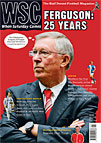 Andy Ollerenshaw tells the story of Enfield Town’s new stadium
Andy Ollerenshaw tells the story of Enfield Town’s new stadium
At the turn of the millennium, fans of Enfield FC saw their beloved football ground bulldozed. But what has happened in the subsequent decade makes for a heartening tale. Formed in 1893, Enfield had a rich and successful history. They played their home games at Southbury Road, an ageing but well-loved 1930s ground, considered by many to be an iconic non-League venue. The sale of Southbury Road in 1999 by Tony Lazarou, who owned the club at the time, initiated a cycle of extraordinary events. Lazarou attempted to rehouse the club at Cheshunt but the move fell through, so for two years the club suffered a nomadic existence, playing at various venues outside the London Borough of Enfield. Fan resentment had already started to grow before the sale of the ground, but the sight of the bulldozers moving into Southbury Road was the final straw for many.
The Enfield Supporters’ Trust was formed to buy the club from Lazarou but, fuelled by his refusal to sell, the fans voted to form a breakaway club in the summer of 2001. David Bryant, the first chairman of the new club, recalls: “The fans were passionate about their club but were angered and felt let down. Everyone involved was, and still is, first and foremost a fan.” At the time this was a ground-breaking proposal but they had invaluable assistance from the embryonic Supporters Direct, even though many questioned whether they were doing the right thing. The fans were determined and Bryant felt that “the adversity made us stronger”. Enfield Town was born.
Enfield Town were the first ever fans’ trust club, creating the template upon which the likes of AFC Wimbledon and FC United of Manchester were later modelled. Ten years on, against all odds, Enfield Town have built their own stadium and have returned the club to a permanent home in the borough. The impressive new Queen Elizabeth II stadium sits only a few hundred metres from the old Southbury Road location and is the fruit of numerous years of toil.
By far the most eye-catching aspect of the QEII Stadium is the art-deco pavilion and grandstand. Along with Great Yarmouth’s Victorian grandstand, it is one of only two Grade II listed structures in non-League football. In the last four years an incredible amount of effort has gone into redeveloping what was a dilapidated building. Without the support of Enfield Council the whole project would have been unfeasible. The council quickly bought into the idea of the club using the venue for football alongside other community projects and they provided funding – as did the Football Foundation, PlaySport London, and the London Marathon Charitable Trust. “We have a fantastic team of people who give their time freely. People who have skills in advertising, promotion, doing hands on work – a great team of 30 to 40 people, a real collective effort. Sadly, we have lost few along the way,c says Bryant.
The idea behind the new stadium was to create something that would be used seven days a week and replace the focal point of the community that was lost when Southbury Road was demolished. There are however still two clubs in Enfield (Enfield 1893 having been formed in 2007 when Enfield FC folded) and getting sponsorship has been a challenge. Chairman Paul Millington hopes the new ground will help attract more support from local businesses: “We have received more sponsorship in the last two weeks than we have in the last two years.”
The QEII Stadium was officially opened on November 16, when Enfield Town entertained a youthful Tottenham Hotspur XI. With 969 in attendance, the hosts won 2-1. Nigel Howard, an Enfield Town director, reflected the mood on the night: “Moving into the stadium marks a very significant step. Now we have a club that represents the spirit of the [original] club.” Barry Ward, a long time fan of the club, summed up the mood well: “This is fantastic. When they sold the old ground it was heartbreaking. I remember crying my eyes out after the last game.” Enfield football fans are still saddened by the demise of Southbury Road, but they are equally proud of their stadium back in the borough.
From WSC 299 January 2012